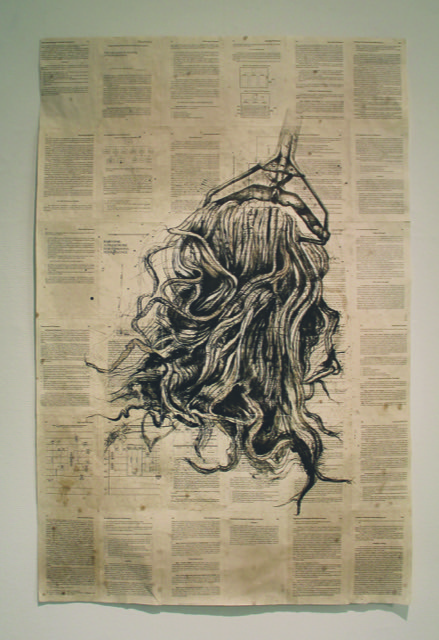

"Economy Model: User Friendly"
Laken Bridges didn’t start out to work in visual arts or to create political art — she wanted to be a fashion designer.
“When you grow up poor, you learn how to get creative: my earliest creations were doll clothes made of old socks. I remember one Christmas, someone gave me a sewing kit that included a bag of sequins. I made sequined tube sock sheath dresses for my Barbie. I made sequined pants for my brother’s GI-Joe. All the dolls were fabulous all the time. I think a big part of being an artist is looking for connections between unrelated things and using existing things in new ways. I have been doing that in some capacity from the beginning.
“I did drawing and watercolor in high school. I was not particularly good, but I stuck with it and developed some skill. I took art in college, because I thought the classes would be fun and relatively easy. They were fun, but difficult. Being skilled in a process is not the same as being a good artist. Making art is more than following design concepts and knowing what colors look good together. It’s also about communicating ideas. That involves being strong enough to showvulnerability and being willing to takerisks. I didn’t figure this out until much later, though. I stuck with my art studies because I liked the challenge. And honestly, I studied printmaking specifically because I refused to be defeated by its processes,” she says.
Bridges trained as a printmaker. Historically it has been used for mass communication because its reproductive nature also allows art to be more affordable and accessible. Bridges hasn’t had regular access to a printing press or print shop for a few years, so her current work tends to be more mixed media.
“These days my focus goes to drawing, collage, handmade books and zines. I am also dabbling in assemblage. I think objects, the values we place on them, and the histories they carry are fascinating,” she says.
She never decided to just start making political art. It happened gradually as a means of communication.
“Art reflects culture, imitates life. I make art about what I am experiencing, what I am learning from others, what I am seeing around me. Some argue that all art is inherently political, which is something to really think about. Certainly not all art is overtly political, butthe act of making art can be a privilege and addressing (or not addressing) a subject in one’s work is a choice.
“There is nothing wrong with decorative art or art for art’s sake. I enjoy a lot of it. But for me personally as an artist, making work that doesn’t examine or question society and culture in some way would be synonymous with me saying ‘I won’t worry about issue x,because it doesn’t directly affect me.’ And then, not being political becomes verypolitical, because it implies one has the privilege of not having to fight for something. Nina Simone once said, ‘An artist’s duty, as far as I’m concerned, is to reflect the times.’ That statement resonates with me.
“I have always been interested in power dynamics. When I was younger, I was concerned with gender roles and gender bias. Those are still relevant issues, but class and labor tend to be at the forefront of my mind and have been for a while now. Class issues feed a lot of other problems.I can’t get behind the bootstrap theory at all. I grew up working class and have watched bodies break to make ends meet. Work ethic does not always guarantee success. I hope my work invites thoughtful conversations about who and what society values.
“The work I was making in my early 20s was introspective and explored my identity through a psychological lens. I took much inspiration from Jungian psychology, Symbolist artists like Ferdinand Hodler and Odilon Redon, and animal symbolism across a variety of cultures. The work eventually transitioned to what I am doing now, because I wanted to focus less specifically on myself and more on stories, experiences and struggles of people and groups of people who are important to me. My earlier work was about creating a feeling. Now it’s about having conversations and asking questions,” she says.
Bridges is a west coast native with Southern heritage and calls South-Central Appalachia home. She holds a bachelor’s degree in French and a Bachelor of Fine Arts in studio art from East Tennessee State University and a Master of Fine Arts in visual arts from Clemson University. Though trained as a printmaker, Bridges works across mixed media. She is the recipient of the George R. McDonald Fellowship and the Cecelia Voelker award in art history, and her work has been exhibited across the United States and internationally. Bridges has worked in education for eight years, six of which were spent teaching at the university level.She works at William King Museum of Art, Abingdon, Virginia, as director of higher education and adult learning.